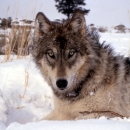Community engagement and collaboration
Questions and Answers: Draft rule & DEIS for proposed Colorado gray wolf experimental population designation
February 15, 2023
---------------------------------------------------------------------
Is the U.S. Fish and Wildlife Service reintroducing wolves to Colorado?
- No. On November 3, 2020, Proposition 114, now codified as Colorado Statute 33-2-105.8, was approved by Colorado voters requiring the state of Colorado to reintroduce gray wolves by December 31, 2023. Colorado Parks and Wildlife (CPW) is the agency responsible for reintroducing wolves to Colorado. The involvement of the Service is related to ensuring appropriate management and management flexibility of the species, given their current status in Colorado as an endangered species under the Endangered Species Act (ESA). For more information about the state of Colorado’s reintroduction of gray wolves, including the Draft Colorado Wolf Restoration and Management Plan, please visit the CPW Wolf Management page.
What is a Section 10(j) designation?
- The Service uses a range of partnerships and conservation tools to recover endangered and threatened species. Section 10(j) of the ESA allows the Service to designate a population of a listed species as experimental if it will be released into habitat outside the species’ current range. A 10(j) rule would help CPW manage the potential impacts of gray wolf reintroduction to stakeholders while ensuring that the reintroduction and management of wolves is likely to be successful and contribute to conservation of the species. Learn more about 10(j) rules and experimental populations.
What management flexibilities are proposed in this 10(j) experimental population designation?
- In the proposed rule available for public review and comment February 17, 2023, through April 18, 2023, the Service has proposed establishing a nonessential experimental population of gray wolves, which would provide additional management measures for CPW and Tribes to address potential conflicts between wolves and humans, and wolves and domestic animals. Management of the proposed nonessential experimental population would allow reintroduced wolves to be hazed, removed, or relocated by CPW, Tribes, or designated agent(s) for domestic animal depredations. Under special conditions and reporting requirements, the public could harass or remove wolves attacking livestock or dogs. Extensive details about the proposed conditions and requirements for the take of reintroduced wolves are available in the draft rule for review on the Colorado gray wolf webpage.
How can an experimental population be designated in Colorado where wolves already exist?
- Experimental populations must be separate from other populations of the species. While several documented wolves currently reside within northern Colorado, the definition of a population of gray wolves as defined by the Service requires two breeding pairs, raising at least two offspring for two consecutive years. The wolves in northern Colorado have not met this definition of a population; thus, the Service can designate wolves reintroduced by the state of Colorado as an experimental population.
Can the state of Colorado reintroduce gray wolves without the Service’s 10(j) experimental population designation?
- Yes. The state can reintroduce gray wolves without the 10(j) experimental population designation, however, without management flexibility provided by the Service through a 10(j) designation, or other means, the state would be limited in its options to manage the federally endangered species appropriately. A 10(j) experimental population designation would allow for the expanded management flexibilities noted above that would otherwise not be available.
What is the current status of protections for gray wolves in the lower-48?
- Following a February 2022 court ruling, gray wolves outside of the northern Rocky Mountains (Montana, Wyoming, Idaho, and portions of Washington, Oregon, and Utah) in the lower 48 are currently listed as endangered, with the exception of Minnesota where they are listed as threatened. For the latest information, please see the Service’s Gray Wolf Recovery News and Updates page.
What are the next steps?
- With the announcement of the proposed section 10(j) rule and associated draft Environmental Impact Statement, the Service is opening a public review and comment period through February 17, 2023, through April 18, 2023. The Service will also conduct a series of public meetings throughout the state of Colorado. Following this public and Tribal engagement period, the Service will review comments and work to develop a final rule and associated Record of Decision (ROD), expected for completion within one year. Please visit the Service’s Colorado Gray Wolf page for additional information and updates.




